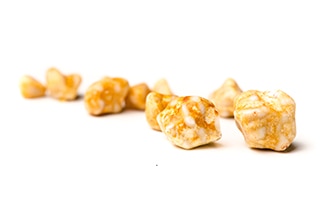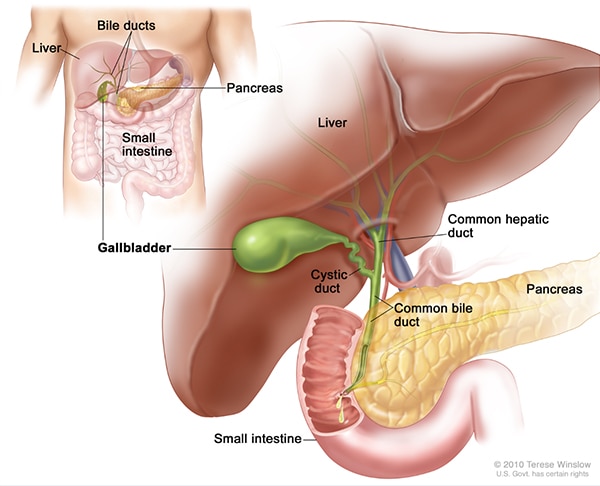Definition & Facts for Gallstones
In this section:
- What are gallstones?
- Do gallstones have another name?
- What is the biliary tract?
- How common are gallstones?
- Who is more likely to develop gallstones?
- What are the complications of gallstones?
What are gallstones?
Gallstones are hard, pebble-like pieces of material, usually made of cholesterol or bilirubin, that form in your gallbladder. Gallstones can range in size from a grain of sand to a golf ball. The gallbladder can make one large gallstone, hundreds of tiny stones, or both small and large stones.
When gallstones block the bile ducts of your biliary tract, the gallstones can cause sudden pain in your upper right abdomen. This pain is called a gallbladder attack, or biliary colic. If your symptoms continue and they’re left untreated, gallstones can cause serious complications.
However, most gallstones don’t cause blockages and are painless, also called “silent” gallstones. Silent gallstones usually don’t need medical treatment.
Types of gallstones
The two main types of gallstones are
- cholesterol stones
- pigment stones
Cholesterol stones are usually yellow-green in color and are made of mostly hardened cholesterol. In some countries, cholesterol stones make up about 75 percent of gallstones.1
Pigment stones are dark in color and are made of bilirubin. Some people have a mix of both kinds of stones.

Do gallstones have another name?
Cholelithiasis is the name doctors sometimes call gallstones.
What is the biliary tract?
Your biliary tract, which is made up of your gallbladder and bile ducts, helps with digestion by releasing bile.
The gallbladder is a small, pear-shaped organ that stores bile and is located in your upper right abdomen, below your liver.
The bile ducts of your biliary tract include the hepatic ducts, common bile duct, and cystic duct. Bile ducts also carry waste and digestive juices from the liver and pancreas to the duodenum.
Your liver produces bile, which is mostly made of cholesterol, bile salts, and bilirubin. Your gallbladder stores the bile until it’s needed. When you eat, your body signals your gallbladder to empty bile into your duodenum to mix with food. The bile ducts carry the bile from your gallbladder to the duodenum.

How common are gallstones?
Gallstones are very common, affecting 10 to 15 percent of the U.S. population, which is almost 25 million people. About a quarter of the nearly 1 million people diagnosed with gallstones each year will need to be treated, usually with surgery.2
Who is more likely to develop gallstones?
Certain groups of people have a higher risk of developing gallstones than others.3
- Women are more likely to develop gallstones than men. Women who have extra estrogen in their body due to pregnancy, hormone replacement therapy, or birth control pills may be more likely to produce gallstones.
- Older people are more likely to develop gallstones. As you age, the chance that you’ll develop gallstones becomes higher.
- People with a family history of gallstones have a higher risk.
- American Indians have genes that raise the amount of cholesterol in their bile, and have the highest rate of gallstones in the United States.
- Mexican Americans are also at higher risk of developing gallstones.

People with certain health conditions
You are more likely to develop gallstones if you have one of the following health conditions:
- cirrhosis, a condition in which your liver slowly breaks down and stops working due to chronic, or long-lasting, injury
- infections in the bile ducts, which can also be a complication of gallstones
- hemolytic anemias, conditions in which red blood cells are continuously broken down, such as sickle cell anemia
- some intestinal diseases that affect normal absorption of nutrients, such as Crohn’s disease
- high triglyceride levels
- low HDL cholesterol
- metabolic syndrome, which can also raise the risk of gallstone complications
- diabetes and insulin resistance
People with diet- and weight-related health concerns
You are more likely to develop gallstones if you
- have obesity, especially if you are a woman
- have had fast weight loss, like from weight-loss surgery, also called metabolic and bariatric surgery
- have been on a diet high in calories and refined carbohydrates and low in fiber
Learn more about dieting and gallstones.
What are the complications of gallstones?
Complications of gallstones can include
- inflammation of the gallbladder
- severe damage to or infection of the gallbladder, bile ducts, or liver
- gallstone pancreatitis, which is inflammation of the pancreas due to a gallstone blockage
Many people do not have symptoms of gallstones until they have complications.
If left untreated, gallstones can be deadly. Treatment for gallstones usually involves gallstone surgery.
References
This content is provided as a service of the National Institute of Diabetes and Digestive and Kidney Diseases
(NIDDK), part of the National Institutes of Health. NIDDK translates and disseminates research findings to increase knowledge and understanding about health and disease among patients, health professionals, and the public. Content produced by NIDDK is carefully reviewed by NIDDK scientists and other experts.

